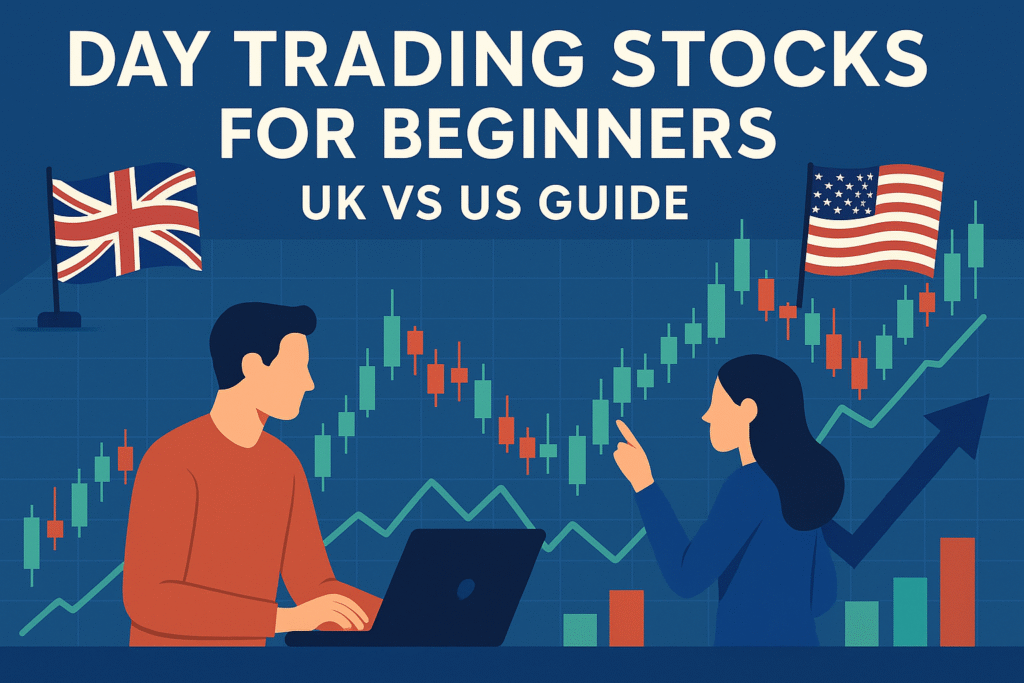Day Trading Stocks for Beginners: UK vs US Guide
Day trading attracts thousands of new traders every year, but success requires more than luck. Whether you’re in London or New York, understanding the basics, regulations, and strategies can help you avoid costly mistakes.
What Is Day Trading?
Day trading is the practice of buying and selling stocks within the same trading day to profit from short-term price movements. Unlike long-term investing, positions are not held overnight, reducing overnight risk but increasing the need for discipline.
Why Beginners Choose Day Trading
- Quick potential returns from short-term price moves.
- No overnight exposure to unexpected news or gaps.
- Accessible platforms with low-cost brokers in both the UK and US.
Day Trading Regulations: UK vs US
United Kingdom (FCA Rules)
- The Financial Conduct Authority (FCA) regulates UK brokers.
- No strict minimum capital requirement for day traders.
- Leverage on CFDs is capped (usually 5:1 for stocks).
- Spread betting profits may be tax-free, but check HMRC guidelines.
United States (SEC & FINRA Rules)
- The Securities and Exchange Commission (SEC) and FINRA enforce rules.
- The Pattern Day Trader (PDT) Rule requires $25,000 minimum equity in margin accounts if you execute 4+ day trades in 5 business days.
- No tax-free exemptions — all gains are taxable as capital gains.
Choosing a Day Trading Broker
UK Brokers
- IG Group (FCA-regulated)
- CMC Markets
- Saxo Bank
US Brokers
- TD Ameritrade (thinkorswim platform)
- Interactive Brokers
- Charles Schwab
Essential Day Trading Strategies for Beginners
1. Momentum Trading
Buy stocks moving sharply higher on news or earnings reports and sell quickly before momentum fades.
2. Breakout Trading
Identify price levels where a stock repeatedly fails to move higher (resistance). When price breaks above resistance with high volume, enter a trade.
3. Pullback Trading
Wait for a stock in an uptrend to dip temporarily, then enter when it starts moving higher again.
4. Scalping
Make many small trades throughout the day, capturing tiny price changes. This strategy requires fast execution and strict discipline.
Tools and Platforms You Need
- Real-time charts from platforms like TradingView or thinkorswim.
- News feeds (Bloomberg, CNBC) to track market-moving headlines.
- Economic calendars for earnings releases and economic data.
Managing Day Trading Risks
- Risk per trade: never risk more than 1–2% of account size.
- Stop-loss orders: exit automatically if price moves against you.
- Avoid overtrading: focus on high-quality setups only.
Tax Considerations
UK
Profits may fall under Capital Gains Tax unless you use spread betting, which can be exempt. Always confirm with HMRC or a tax advisor.
US
All gains are taxable. Short-term trades are taxed at regular income rates, not long-term capital gains rates.
Practical Tips for Beginners
- Start with a demo account before risking real money.
- Trade liquid stocks with high volume (Apple, Tesla, Microsoft).
- Record every trade to review mistakes and improve.
- Keep emotions in check. Day trading requires strict discipline.
Key Takeaways
- Understand your region’s rules (FCA vs SEC/FINRA).
- Choose a reliable, low-cost broker.
- Focus on risk control as much as strategy.
- Practice with virtual trading before going live.
Want to build your day trading skills? Keep learning, test strategies in a demo environment, and aim for consistency over quick wins.





